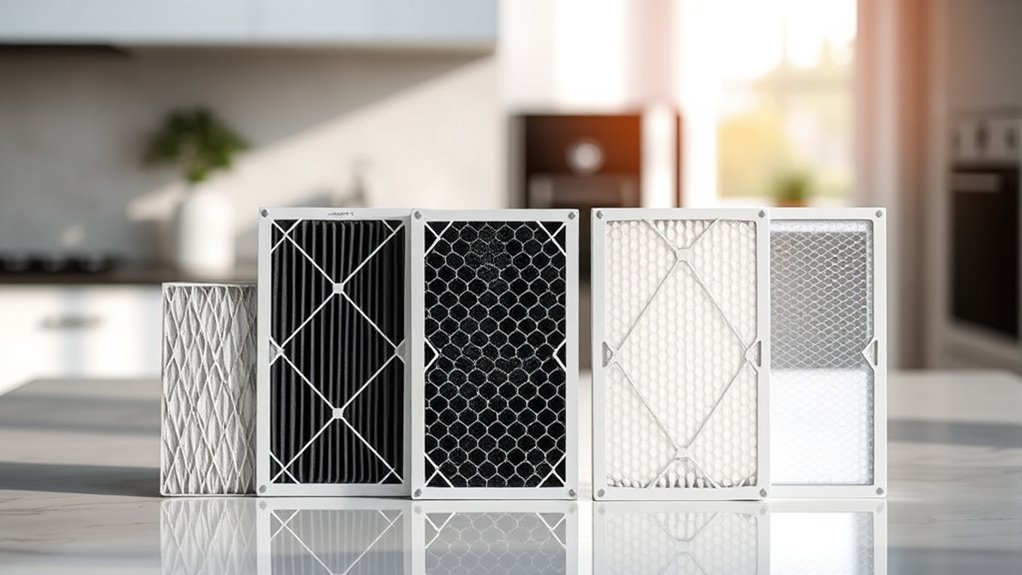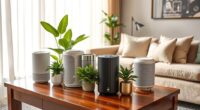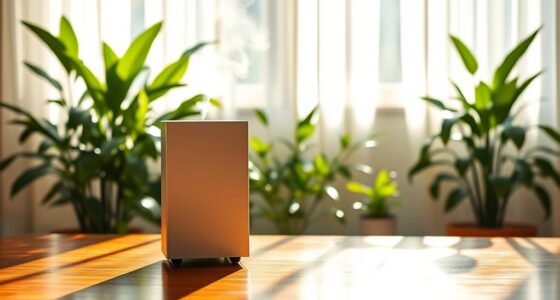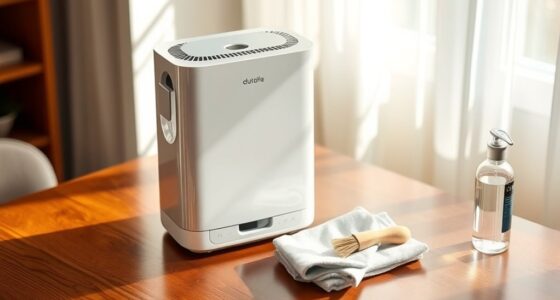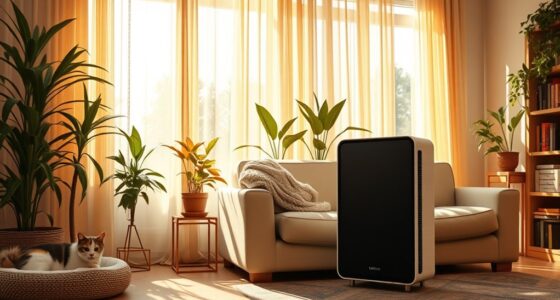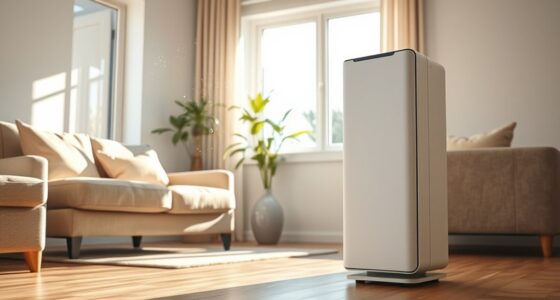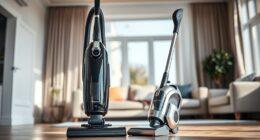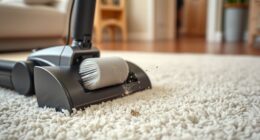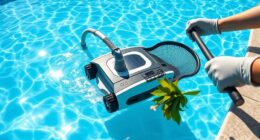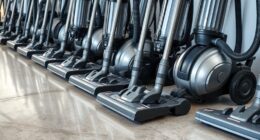Air purifier filters are essential for improving your indoor air quality by trapping various airborne particles. HEPA filters are the gold standard, capturing 99.97% of pollutants. UV filters help disinfect the air, while electrostatic filters are a cost-effective option. Washable filters are eco-friendly, and media filters provide enhanced filtration. Spun glass filters offer basic protection, and pleated filters balance efficiency with cost. Each type has its benefits, and you’ll find even more insights as you explore further.
Key Takeaways
- HEPA filters capture at least 99.97% of airborne particles, making them the most effective for allergens and harmful pollutants.
- Activated carbon filters absorb gases and neutralize odors, effective against volatile organic compounds (VOCs).
- Electrostatic filters are budget-friendly and environmentally friendly but require regular maintenance to ensure effectiveness.
- Washable filters are reusable and eco-friendly, but they typically have lower filtration efficiency compared to HEPA filters.
- Multi-stage filtration systems combine various filter types for optimal air purification performance and efficiency.
What Are Air Purifier Filters?

Air purifier filters are the heart of these devices, playing a crucial role in enhancing your indoor air quality. They work by capturing airborne particles and pollutants like allergens, dust, and smoke.
The most effective type is HEPA filters, which can trap at least 99.97% of particles as small as 0.3 microns, making them excellent for reducing allergens. Air purifiers that utilize HEPA filters are particularly beneficial for allergy sufferers. Activated carbon filters complement HEPA filters by adsorbing gases and neutralizing odors, such as volatile organic compounds (VOCs). Many models also incorporate UV light technology, which can help kill germs and bacteria, further improving air quality. Regular cleaning of filters is essential to maintain their performance and extend their lifespan. In addition, the presence of a multi-stage filtration system can significantly enhance the overall air purification process.
Pre-filters act as the first line of defense, capturing larger particles and extending the life of HEPA filters. Many air purifiers use a multi-stage filtration system, combining these filters to maximize purification efficiency and guarantee cleaner, healthier air in your home. Additionally, regular filter replacement is crucial for maintaining optimal performance and ensuring effective pollutant removal.
HEPA Filters: The Gold Standard

When it comes to air purification, HEPA filters stand out for their impressive filtration efficiency, capturing 99.97% of airborne particles. You’ll appreciate the health benefits they offer, especially if you suffer from allergies or respiratory issues. Regular maintenance, such as cleaning filters every 1-3 months, is essential to guarantee they continue to perform effectively. Additionally, regular filter replacement is crucial for optimal performance to ensure you enjoy the benefits of HEPA filter technology. Understanding filter replacement signs can also help you maintain the efficiency of your air purifier. Furthermore, regular filter replacement is necessary to ensure continuous allergen removal, promoting better air quality in your environment. In addition, using a HEPA filter can significantly enhance your overall well-being by reducing exposure to harmful airborne pollutants.
Filtration Efficiency Explained
Although many filters claim to improve indoor air quality, HEPA filters stand out as the gold standard in filtration efficiency.
Designed to capture at least 99.97% of airborne particles that are 0.3 microns in size, HEPA filters effectively trap common pollutants like dust, pet dander, and pollen. This level of filtration can significantly enhance your indoor environment, similar to how color accuracy impacts overall image quality in projectors. Additionally, hydrocolloid technology is a vital concept in skincare that promotes healing by drawing out impurities, much like the way HEPA filters purify air. Furthermore, the efficiency of HEPA filters contributes to lower carbon footprints by improving indoor air quality without excessive energy consumption. Regular air quality assessments can help determine the effectiveness of your mammography screening, as both are crucial for maintaining health.
With a Minimum Efficiency Reporting Value (MERV) rating near 16, they outperform standard air filters.
Studies show that HEPA purifiers can reduce airborne viruses, including COVID-19, by up to 48%.
Their unique fibrous structure allows for high airflow while efficiently trapping harmful particles.
To maintain ideal filtration efficiency, it’s essential to replace filters every 2-4 years, ensuring your air purification system continues to perform at its best. Additionally, many best HEPA filter vacuums are designed to complement air purifiers by further reducing indoor allergens.
Health Benefits Overview
HEPA filters aren’t just about impressive filtration efficiency; they offer significant health benefits that enhance your indoor environment. By capturing at least 99.97% of airborne pollutants like pollen, pet dander, and dust mites, HEPA air filters can dramatically improve indoor air quality. Research shows they even reduce the incidence of COVID-19 by 48%, making them essential during health crises. Their specialized design traps bacteria and viruses, providing a vital layer of protection. Additionally, using natural remedies alongside HEPA filters can further contribute to a healthier indoor environment. Incorporating gold IRA strategies can also help you invest in protective measures for your health and wealth. To maintain these health benefits, you must replace filters every 2-4 years, as they can become saturated with harmful particles. Moreover, continuous monitoring of air quality can help ensure the effectiveness of these filters over time. Regular cleaning of your living space, similar to the routine cleaning required for pet care, can also enhance overall air quality. Incorporating UV light with HEPA filters can further enhance their effectiveness, ensuring your home stays a safe haven. The use of sound design techniques can also create a calming atmosphere, reducing stress levels in your indoor environment.
Maintenance and Lifespan
Maintaining your HEPA filter is essential for ensuring it continues to perform at its finest. These filters are the gold standard for improving air quality by trapping at least 99.97% of airborne particles. Their typical lifespan ranges from 2 to 4 years, depending on usage and environmental factors, so periodic maintenance is vital. Regularly check for saturation and replace your HEPA filters to avoid airflow restrictions. If your filter has pre-filters, be sure to clean or replace them as well, as they capture larger particles and can extend the lifespan of your HEPA filter. Additionally, awareness of the importance of maintenance can significantly enhance the efficiency and longevity of your air purification system.
UV Filters: Disinfecting Air

UV filters play an important role in disinfecting the air by using short-wave ultraviolet light to target and kill bacteria and viruses. These filters enhance air quality by eliminating airborne pathogens, including mold spores, contributing to a healthier indoor environment. However, it’s essential to remember that UV filters don’t capture dust or allergens, so combining them with HEPA filters is often recommended for thorough purification. Some UV filters can produce ozone, which may be harmful to health, necessitating careful selection. Regular maintenance is also critical to guarantee peak performance.
| Feature | Benefit | Consideration |
|---|---|---|
| Disinfecting Air | Kills bacteria & viruses | Doesn’t filter dust/allergens |
| Enhances Air Quality | Improves indoor environment | May generate ozone |
| Effectiveness | Targets microorganisms | Requires regular upkeep |
Electrostatic Filters: The Cost-Effective Choice
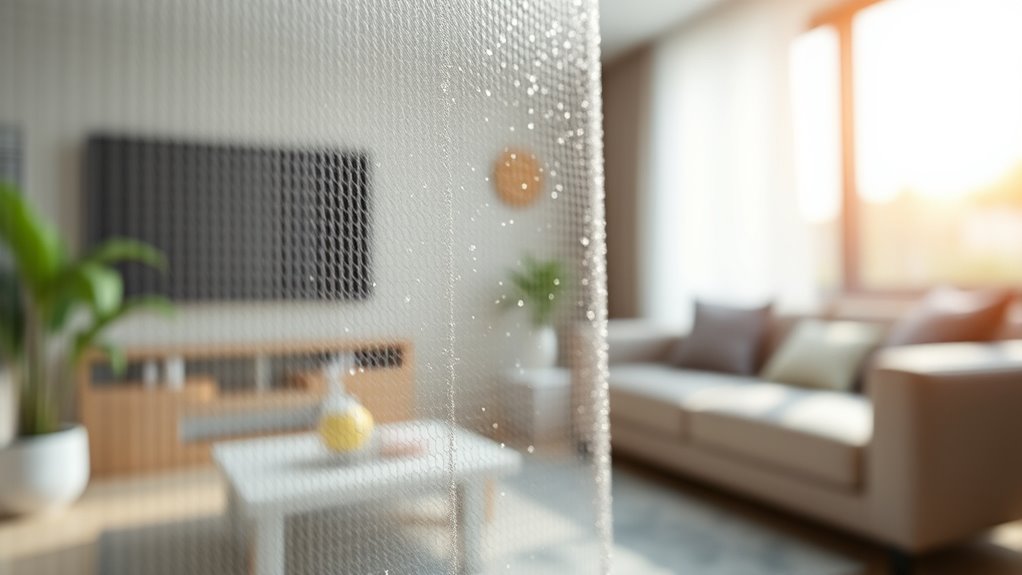
If you’re looking for a budget-friendly air purification option, electrostatic filters might be the answer.
They offer cost savings and can be either disposable or reusable, but you need to keep up with regular maintenance to guarantee they work effectively.
However, be aware of their limitations when it comes to filtering larger particles, and consider your specific air quality needs.
Cost Savings Overview
When it comes to air purification, electrostatic filters stand out as a cost-effective choice that won’t break the bank. These filters use static electricity to attract airborne particles and can be either disposable or reusable.
Opting for reusable filters means you’ll enjoy significant cost savings, as you can wash and reuse them multiple times. Typically, electrostatic filters have a longer lifespan than standard disposable filters, reducing replacement frequency and overall maintenance costs.
While they may not capture larger particles like dust or mold spores as effectively, they remain a budget-friendly choice for enhancing indoor air quality. Plus, using electrostatic filters contributes to less waste, making them an environmentally friendly option for cost-conscious consumers.
Maintenance and Cleaning Tips
To keep your electrostatic filter performing at its best, regular maintenance is essential.
These filters need consistent cleaning to maintain their efficiency and effectiveness. A dirty filter can reduce airflow and purification performance, which is counterproductive.
To clean your electrostatic filter, simply rinse it with water and let it dry completely before reinserting it into the air purifier. This process not only extends the life of your filter but also guarantees peak air quality by effectively trapping airborne particles.
Filtration Efficiency Limitations
While electrostatic filters offer a cost-effective solution for enhancing indoor air quality, their filtration efficiency has notable limitations.
These filters excel at capturing smaller particles using static electricity, but they struggle with larger pollutants like dust and mold spores. This limitation can reduce their overall effectiveness, especially for those concerned about respiratory issues.
Unlike HEPA filters, electrostatic filters may not adequately filter fine particles that can aggravate health conditions. Additionally, potential ozone emissions during operation raise health concerns, necessitating caution in indoor environments.
If you’re considering electrostatic filters, it’s essential to weigh these limitations against your specific air quality needs to guarantee you’re making the right choice for your health and home environment.
Washable Filters: Eco-Friendly Options
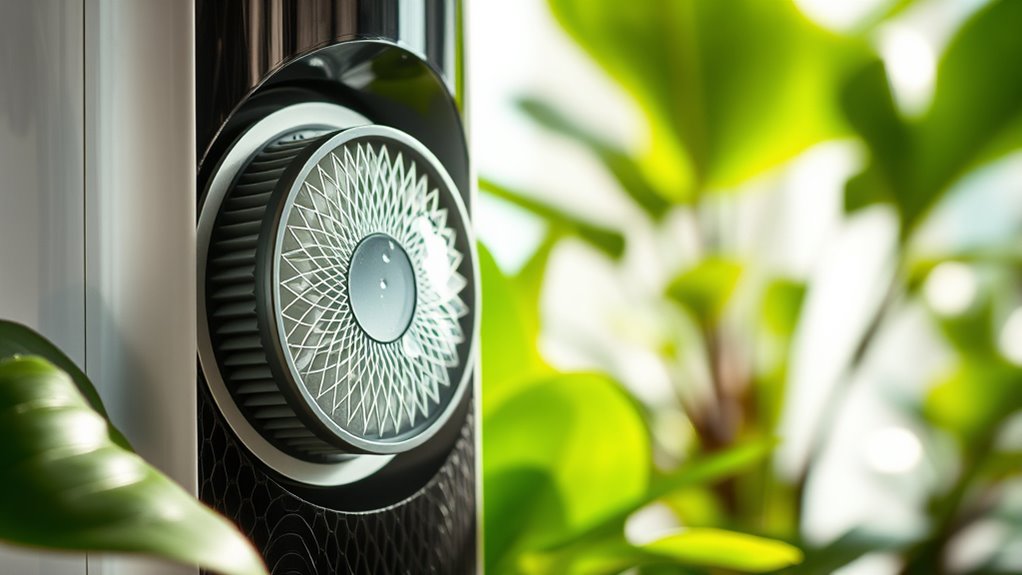
If you’re looking for an eco-friendly air purification solution, washable filters might be the perfect choice for you.
These environmentally friendly options allow you to clean and reuse the filters multiple times, reducing waste. While they come with a higher initial cost compared to disposable filters, they can be a cost-effective investment over time.
However, it’s important to follow user manuals for proper cleaning schedules and methods, as improper maintenance can lead to mold and mildew.
Keep in mind that washable filters generally have a lower MERV rating, which may not meet the needs of those with allergies or respiratory issues.
Consider your air quality requirements before opting for washable filters.
Media Filters: Enhanced Filtration

Media filters provide an impressive level of air purification, making them a top choice for those seeking enhanced filtration.
With high MERV ratings above 13, these filters capture a wider range of airborne particles, including allergens and dust. Their greater surface area boosts filtration efficiency, allowing them to accommodate more pollutants without obstructing airflow. This is vital for maintaining peak airflow within HVAC systems.
You’ll find media filters versatile, suitable for both residential and commercial settings.
To keep them working effectively, regular maintenance and timely replacement are necessary. By prioritizing these practices, you not only guarantee cleaner air but also prolong the life of your HVAC system, making your investment in media filters even more worthwhile.
Spun Glass Filters: Basic Protection
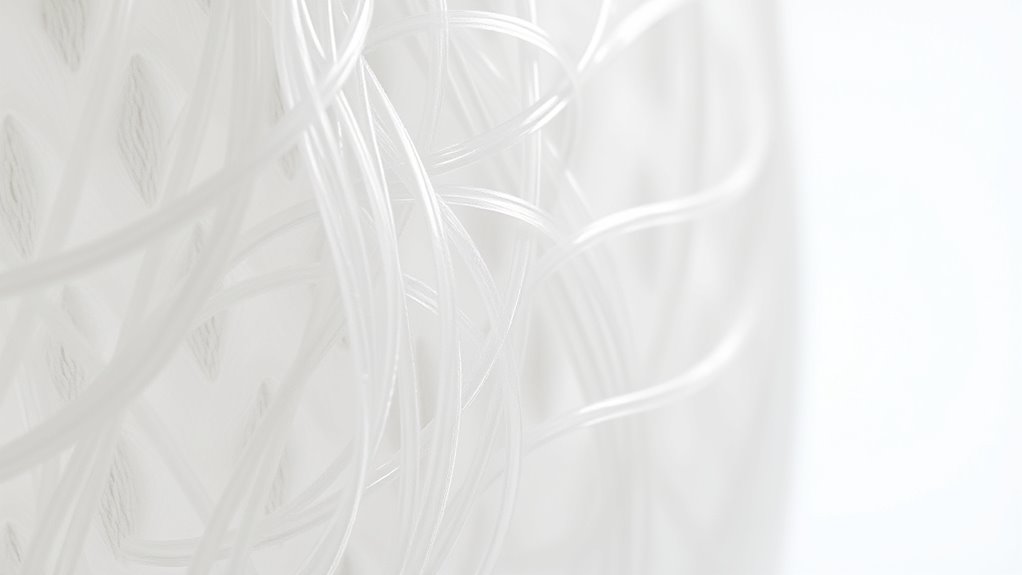
For those seeking basic air filtration, spun glass filters offer a straightforward solution. These filters are made from spun glass fibers, effectively capturing larger particles like dust and lint.
However, their limited effectiveness means they struggle with smaller pollutants, making them less suitable for improving overall air quality. With lower MERV ratings, spun glass filters can’t effectively filter allergens or harmful microorganisms, which is vital for individuals with allergies or respiratory issues.
While they’re low cost and easy to replace, remember that if you’re concerned about indoor air quality, you might need a more advanced filtration method to guarantee you’re adequately filtering out harmful particles.
Spun glass filters provide basic protection, but your needs may require something more robust.
Pleated Filters: Balancing Efficiency and Cost
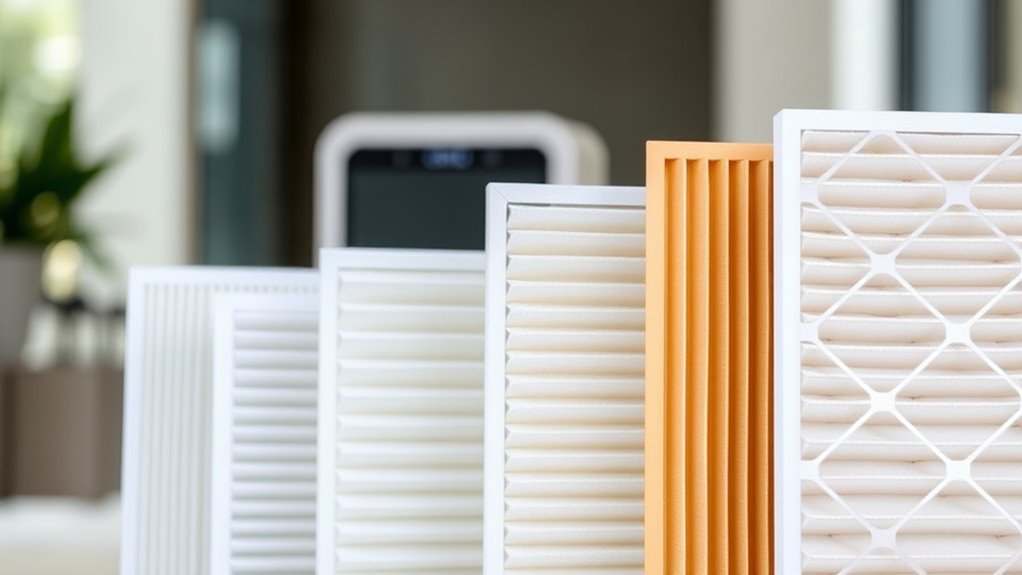
While spun glass filters provide basic protection, pleated filters offer a significant upgrade in air filtration efficiency and cost-effectiveness.
Made from folded fabric, pleated filters maximize surface area to capture a wider range of airborne pollutants, effectively filtering out dust, pollen, and pet dander with higher MERV ratings between 8 and 12.
This enhanced filtration efficiency makes them ideal for improving indoor air quality in your home. They’re also compatible with various HVAC systems, ensuring versatility without hindering airflow.
To maintain their performance, regular replacement every 6 to 12 months is essential.
Frequently Asked Questions
What Are the Different Types of Air Purifiers Filters?
When considering air purifier filters, you’ll encounter several types.
HEPA filters capture 99.97% of tiny particles, perfect for allergy sufferers.
Activated carbon filters absorb odors and gases.
Electrostatic filters use charged plates to attract particles, while UV filters kill bacteria and viruses using ultraviolet light.
Finally, washable filters are eco-friendly and reusable but need regular maintenance.
Each type serves a unique purpose, so choose based on your specific air quality needs.
What Is the Best Type of Filter for an Air Purifier?
If you want the ultimate air purification experience, you can’t go wrong with HEPA filters!
They’re like the superheroes of the air purifier world, capturing 99.97% of those pesky particles as tiny as 0.3 microns.
Allergens like dust and pet dander won’t stand a chance!
While activated carbon filters tackle odors and VOCs, combining them with a HEPA filter gives you the best of both worlds and guarantees your indoor air is pristine.
Which Filter Is Better, HEPA or MERV?
When deciding between HEPA and MERV filters, it really depends on your needs.
If you’re dealing with severe allergies, HEPA filters are often the better choice, as they capture at least 99.97% of particles down to 0.3 microns.
On the other hand, MERV filters can improve overall air quality by capturing a wider range of particle sizes, but they may not be as efficient for the smallest allergens.
Consider what matters most for your situation!
What Is the Difference Between the Different Types of Filters?
Did you know that HEPA filters can capture 99.97% of airborne particles as tiny as 0.3 micrometers?
When you consider different filter types, HEPA excels at trapping allergens, while activated carbon filters absorb odors and gases.
Electrostatic filters use charged particles but may produce ozone, and UV filters disinfect but don’t filter dust.
Media filters combine high efficiency with airflow, making them versatile for various systems.
Each has unique strengths tailored to specific needs.
Conclusion
Now that you’ve explored the different types of air purifier filters, imagine breathing in crisp, clean air, free from dust and allergens. Each filter type offers unique benefits, ensuring your home feels like a revitalizing gust of mountain air. Whether you choose HEPA for its unmatched efficiency, or a washable filter for eco-friendliness, you’re on your way to a healthier living space. So go ahead, take a deep breath, and let your air purifier work its magic!
